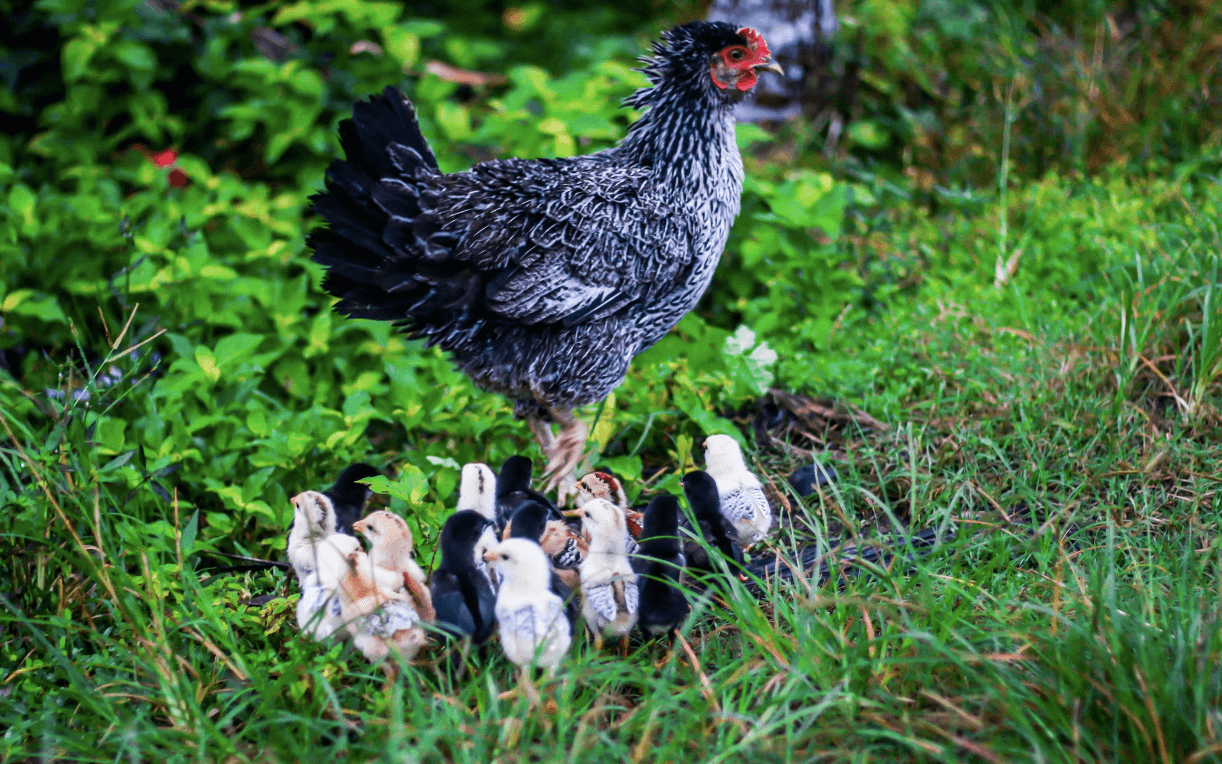Your baby chicks are warm and thriving in their brooder, growing nicely and eagerly awaiting the day they can venture into the great outdoors. But how do you know when can chicks go outside?
Timing is everything when it comes to ensuring the health and safety of the new additions to your flock. You have to take various factors into account to make informed decisions about when to introduce them into your backyard coop.
In this article, we’ll delve into the signs that show your chicks are ready to take their first steps outside. We’ll also give you some tips on how to prepare your babies for their transition to living outdoors so that they can explore safely and confidently when the time comes.
When Are Chicks Ready to Enter the Coop?
Chicks are old enough to venture outside once they are fully covered in feathers and able to regulate their body temperatures by themselves. This usually occurs at around 6–8 weeks of age, although this depends on the breed of your birds.
You should also take environmental factors into account before allowing your chicks to roam outdoors. Young birds should be kept at the following temperatures when inside:
This means that once outside conditions match the 70ºF of the brooder, it’s safe to let your babies roam outdoors. The weather should also be dry and mild to ensure their comfort.
Never put young birds outside during the winter, as they’ll be at risk of freezing. It’s incredibly difficult to bring back a chick that has gotten a chill, so it’s essential that you protect them from exposure to the cold, especially during their first few days outside.
How to Make the Transition
Making the transition from the brooder to the chicken coop is best done in stages. This allows your chicks to gradually acclimate to their new surroundings and minimizes stress.
Here are the steps to take to successfully introduce your baby birds into their outdoor environment.
Prepare the Chicken Coop
A crucial first step to take in transitioning your chicks to the outdoors is to ensure that your coop is adequately prepared for them. The area must provide your babies with a safe and comfortable living space.
Start by inspecting your chicken coop for any openings or gaps where predators may enter and harm the chicks. Seal off these areas with sturdy wire mesh.
Our chicken coop predator protection kit is excellent for this purpose, as it keeps other animals out. Its durable and high-quality design allows your birds to roam freely inside their run, along with being built to last.
If you already have adult hens in your coop, create a separate space where the chicks can initially be kept apart from them. Use some wire fencing to make a partition, or “playpen,” on one side of the enclosure, ensuring the young birds have access to their own food and water.
Make sure that the chicks and adult birds are still able to see each other through this barrier. This allows them to get used to one another without making any physical contact, protecting the babies from any potentially dangerous pecks or kicks.
Let the Chicks Out Into Their Playpen For Short Periods
Before your chicks start to live outside permanently, they should go outdoors for short periods to help them get used to it gradually.
If outside temperatures allow it, let your chicks spend some time in their playpen each day. Start with sessions of around 15–30 minutes and slowly increase these times as the chicks become more confident.
You should supervise your young birds closely during these periods to keep them safe and monitor their behavior.
Chicks should be active, curious, and exploring their surroundings. Should any birds appear stressed, scared, or lethargic, it may be a sign that they’re not yet ready for the outdoors.
The adult birds in the coop also need this time to get used to seeing and smelling the chicks in their space.
After their time in the coop, gently guide your chicks back into their brooder and allow them to settle back into their familiar surroundings. This warm and secure environment helps them recuperate and prepare for their next outdoor adventure.
Leave the Chicks in the Coop
Once the chicks are around 10 weeks old and used to being outside during the day, you can leave them in the coop permanently. They should still be inside their playpen to keep them separated from the other adult birds.
After about two weeks, remove the partition to fully integrate them into the flock. However, keep in mind that the birds still have to establish a pecking order regardless of how often they’ve seen each other through the barrier.
Monitor their first encounters closely and quickly remove any chicks that the older hens appear to be picking on.
As the flock’s hierarchy becomes established, you can give the chicks more freedom in the coop and allow them into runs. You should still continue to observe their interactions and intervene if you see any bullying or aggression taking place.
Winter Precautions
Almost all chicken keepers agree that spring and summer are the best months to let your chicks outside for the first time. Raising chicks can be slightly more difficult if you live in a climate that experiences cold for most of the year.
In these situations, it’s best to keep your chicks in their brooder for as long as possible. Allow them to stay safely indoors until they’re around 12–16 weeks old.
At this point, the chicks will be too large to stay in their brooder for much longer and you’ll need to take precautions to help them withstand the cold outdoors.
Ensure your chicken coop is well-insulated and free of drafts to provide enough protection from harsh winter conditions. Check for any cracks in the walls and seal them to prevent any chills from entering.
Provide your birds with a deep layer of bedding, like straw or wood shavings, to help insulate the floor and keep the chicks warm.
Also consider adding an extra heat source, like a chicken coop heater, to give your birds warmth during extremely cold spells.Please make sure you don’t use heat lamps due to the risk of fire.
By taking these steps, you can help your chicks stay comfortable and healthy during the cold winter months.
How to Tell if Chicks Are Cold
Once you’ve let your chicks outside, it’s essential to monitor their comfort and well-being. During cooler weather, you should check up on them often to make sure they aren’t feeling the cold.
Look out for the following signs that your birds are getting too chilly:
- Huddling together
- Lethargy
- Fluffed feathers
- Shivering
- Pale combs and wattles
- Decreased appetite
Should you observe any of these behaviors in your young birds, quickly bring them inside. Indoor temperatures of around 65ºF will be enough to slowly warm them up and get them back to eating and drinking normally.
Only let them back outside once they have fully recovered and are no longer showing any signs of being cold.
When Can Chicks Go Outside? Here Are Mistakes to Avoid
Introducing your chicks to the great outdoors for the first time is an exciting experience, but you should approach this transition with care.
One of the most common mistakes that chicken keepers make is putting their babies outside too early. Young birds need time to develop their feathers and build up their strength before they can tolerate outdoor conditions.
Premature exposure to cold, wet, or windy weather often leads to chills and other health issues.
It’s also crucial to always closely observe your chicks during their first few outdoor adventures. Without proper supervision, they may escape the coop or become the focus of a predator. Always keep an eye on your babies and intervene if necessary to ensure their safety.
Before allowing chicks outside, consider the weather and avoid putting them in extreme heat, cold, wind, or rain. Your safest bet is to wait for mild, dry weather with moderate temperatures before allowing them to explore their new coop.
Ready, Set, Explore!
Preparing your chicks for the great outdoors is as much about preparation as it is timing. By taking gradual steps to get them used to being outside, you can ensure a smooth transition that will see them happily exploring the world in no time.
You can always get in touch should you have any questions on when can chicks go outside, or anything else on your chicken-raising journey. We’re here to help ensure the health and safety of the new additions to your coop. Ready, set, explore!





